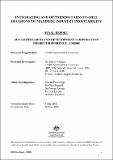| Abstract | Late in the 1990’s, the Australian sugar industry recognised the need to achieve increased integration across its value chain, so as to reduce costs and increase international competitiveness. Past projects and independent assessments highlighted the harvesting and transport interface as being a high priority due to its current logistical inefficiencies and large potential economic benefits from removing these. The logistical inefficiencies were partly manifested by the social and ownership differences between these sectors. CSE005 aimed to explore and implement multiple opportunities to achieve economic benefits at the harvesting and transport interface of the value chain, using a combined participatory action research and technical modelling approach. The project used case studies, initially being the Mourilyan, Mossman and Plane Creek regions. Each case study had a local industry working group, to drive the process of building models, validation, and developing pathways to adoption. Mourilyan was the basis for the model development due to the broad range of opportunities that the region was to explore and due to its technical capacity to work closely with the research team. This research team was multi-disciplinary across CSIRO, BSES and Harvesting Solutions due to the broad range of modelling expertise required in harvesting and transport. One of the first steps with the Mourilyan case study was to conceptualise the value chain in harvesting and transport, which defined the key linkages and drivers across these sectors. This was the basis for formulating a modelling framework which defined the interactions between the industry component models, some of which already existed within the industry. A modelling framework approach was better than building a super-model since it was more transparent to the local industry working groups, more robust and had greater industry ownership. Throughout the life of the Mourilyan case study, the modelling work underwent many revisions (over a one-year timeframe) through the participatory action research process. During this process, the case study regions developed and refined options (or scenarios) for the models. This provided the case study working group with a growing understanding of best-bet options for the local region and the benefits across the participants of the chain. Opportunities identified across the case study regions collectively fell into the themes of: increased time window of harvest through staggering the start times of harvesters; harvest best practice; improved seasonal logistics; transition to larger harvesting groups; and rationalisation/upgrading of transport infrastructure. Their collective potential benefits from these options was in excess of $2.00/tc for some case studies. The increased time window of harvest option was adopted immediately in the Mourilyan and Mossman regions due to minimal change management and no capital investment requirements, and continued to be implemented throughout the life and beyond CSE005. Harvest best practice started to be piloted in Mourilyan as a result of CSE005, though its adoption was often hampered by pressure to fill bins and disruptions. Whilst the Mourilyan and Mossman regions agreed the time window of harvest options were beneficial, an evaluation based on factual data was impossible due major changes in the base line evaluation (e.g. changed number of harvesting groups, tonnes crushed at each mill) from 2002 to 2005. About mid-way through CSE005, the Mourilyan and Plane Creek case studies ended pre-maturely due to reasons beyond the control of the project team. Whilst this was a disappointment for the project team and for many of the participants in the local industry working groups, the Herbert quickly became a replacement case study. |

